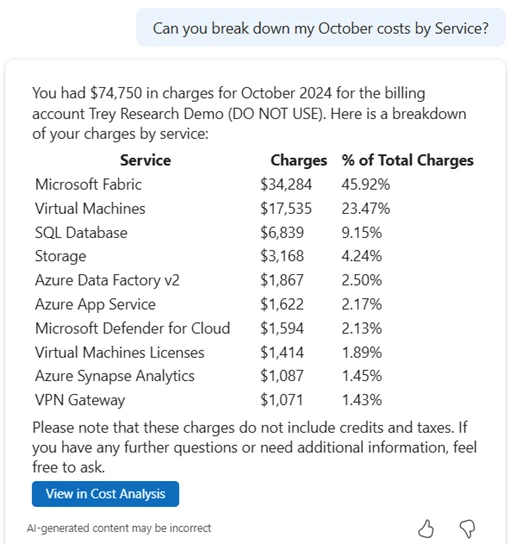At Microsoft Ignite, we announced key product updates to enable your FinOps journey.
As you may know, November is the month of Microsoft’s biggest customer and partner event – Microsoft Ignite. This year, at the event, the Cost Management team announced key product updates to enable your FinOps journey. Below is a summary of these improvements. We invite you to explore and take full advantage of these new features!
Let’s dive into the details.
Export to Microsoft Fabric
Export is a great way to get cost and price data sets for storage, analysis and reporting needs. It is very easy to set up and you can configure it to run on a recurring schedule without manual intervention. You can quickly set this up using the Azure Portal or via the API. We’ve made several improvements to our export solution this year, including support for additional datasets, parquet format support, and compression. We just added another one to this list! At Ignite, we announced limited availability of our Exports to Fabric OneLake connector. With this new feature, you can export cost and pricing datasets directly into Microsoft Fabric, saving you the time and effort of processing cost data into Fabric from your storage account.
Please note that this feature is not yet generally available. By submitting this form, you can opt-in to enable this feature for your account. Our team will contact you via email with the relevant instructions during January.
With Microsoft Fabric, you get a unified platform for your data storage, analytics, and reporting needs. You can combine data from multiple sources and use the integrated Power BI Fabric to create report dashboards for your business needs. In addition, you can use natural language prompts to gain insight into your data and for predictive analytics. Learn more about Fabric and its powerful capabilities.
Cost of Azure OpenAI service
View Azure OpenAI
In our last blog, I wrote about how easy it is to manage Azure OpenAI service costs in cost analysis. You can analysis costs for different time periods, monitor costs using scheduled emails and budgets and optimize your costs by leveraging Azure OpenAI provisioned reservations.
To make your Azure OpenAI cost analysis even easier, we’re excited to announce the availability of a new integrated view: Azure OpenAI. In this new view, you can see the running costs of all your models for different time periods (both actual and amortized). This view also includes the cost of reservation purchases if the purchase subscription is in the selected range.
You can access this view under Cost Analysis under All Views -> Smart View as shown in the screenshot below:
Co-pilot simulation for Azure OpenAI service
As you already know, Copilot is a great tool for getting your cost questions answered using natural language. As an example, you can ask Copilot about your costs to run an Azure OpenAI deployment, as shown in the prompt below:

Now, we’ve expanded our Copilot capabilities to even help you estimate the cost of your token-based Azure OpenAI deployment. An example of a challenge is shown below:

This is just the beginning, we will continue to make improvements to support more simulation scenarios, making it easier for you to estimate and therefore plan your Azure spend.
As always, you can continue to use the pricing calculator for all your estimating needs, including Azure OpenAI.
Azure Copilot to Cost Analysis
We’ve made an exciting update to your Copilot cost management experience by integrating cost analysis into the responses generated by Copilot. In most responses you will notice the “View in Cost Analysis” which will take you to a customized cost analysis view based on your challenge. This allows you to perform additional actions in cost analysis, such as analyzing costs with different parameters, sharing the view with others on your team, receiving email alerts, and more.
To trigger this feature, simply ask a cost-related question as usual. No additional configuration is required. By way of example:

Clicking the “View in Cost Analysis” button in the response will open a new cost analysis view grouped by service name for October 2024. You can focus on your task while Copilot performs the required configurations for you!
If you haven’t tried Copilot in Azure for your cost questions, I strongly encourage you to try some of the sample challenges we have for you to get started.
New ways to save money in the Microsoft cloud
Here are some deals that can help you cut costs:
Documentation update
Here are some documentation updates you might be interested in:
Do you want to keep track of all documentation updates? See the change history in the cost management and invoicing documentation in azure-docs repository on GitHub. If something is missing, select it Edit at the top of the document and submit a quick download request. You can also submit an issue on GitHub. All contributions are welcome and appreciated!
what’s next
These are just some of the big updates from last month. Don’t forget to check out previous Microsoft Cost Management updates. We’re always listening and always improving based on your feedback, so please keep the feedback coming.

